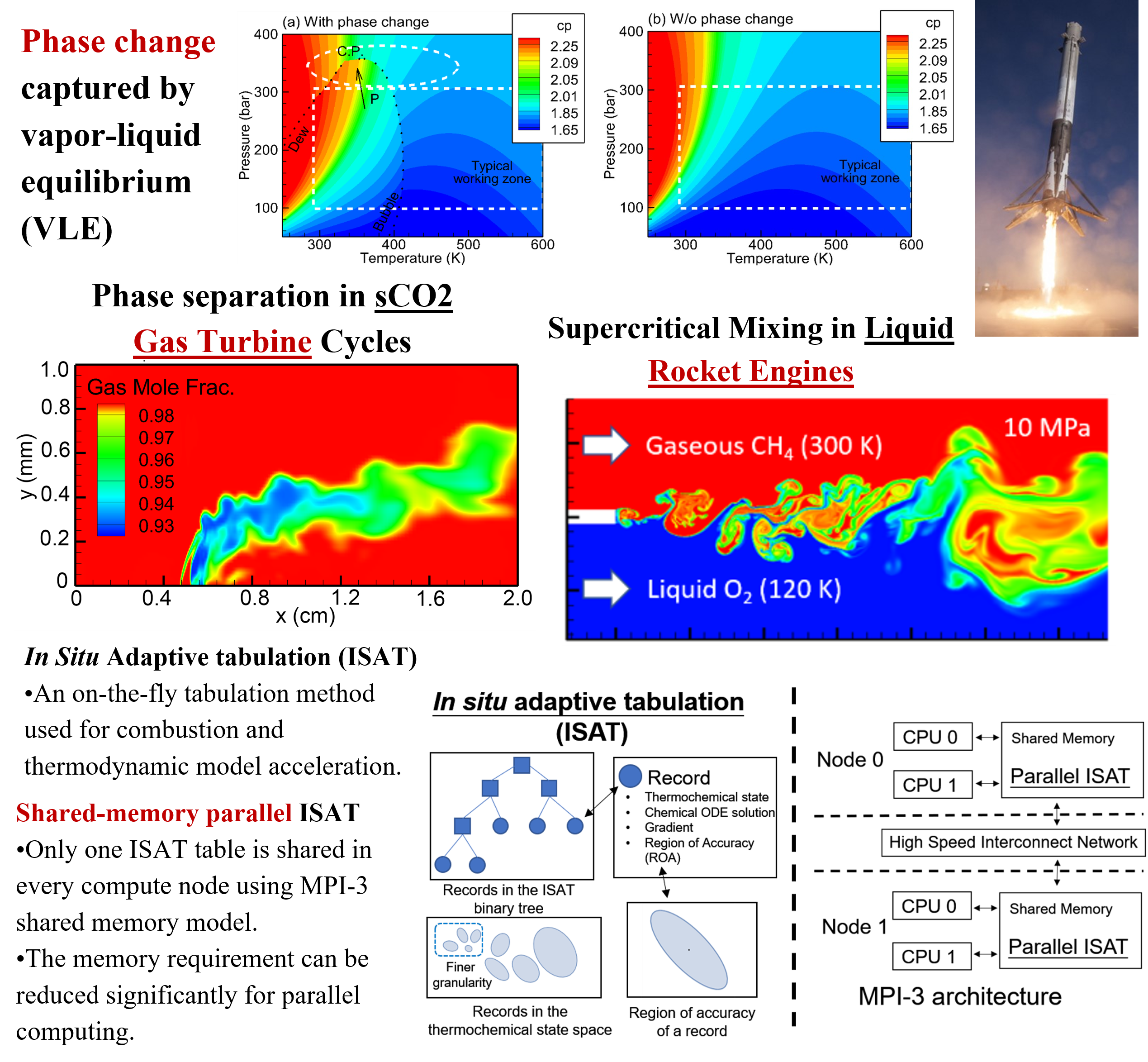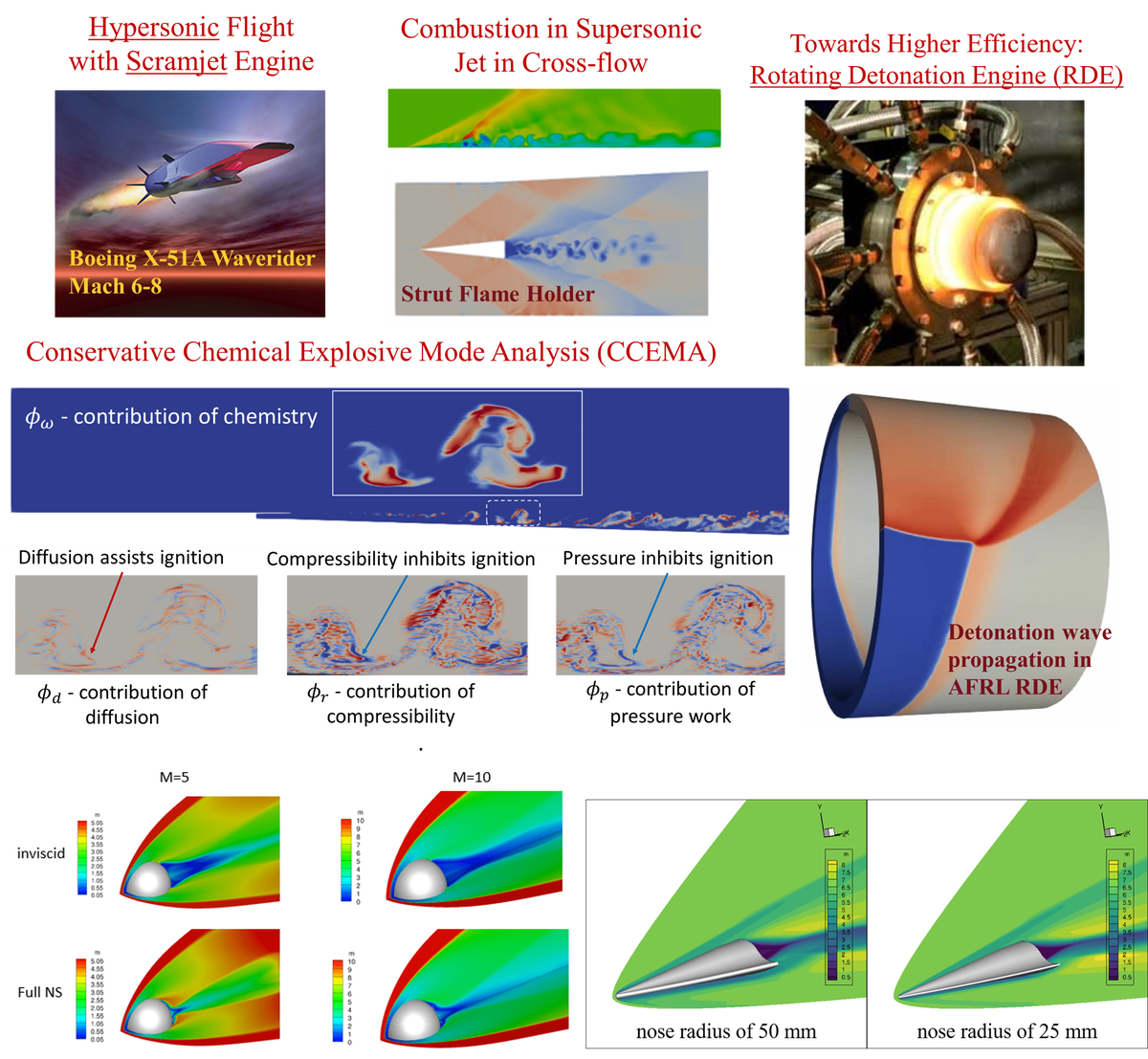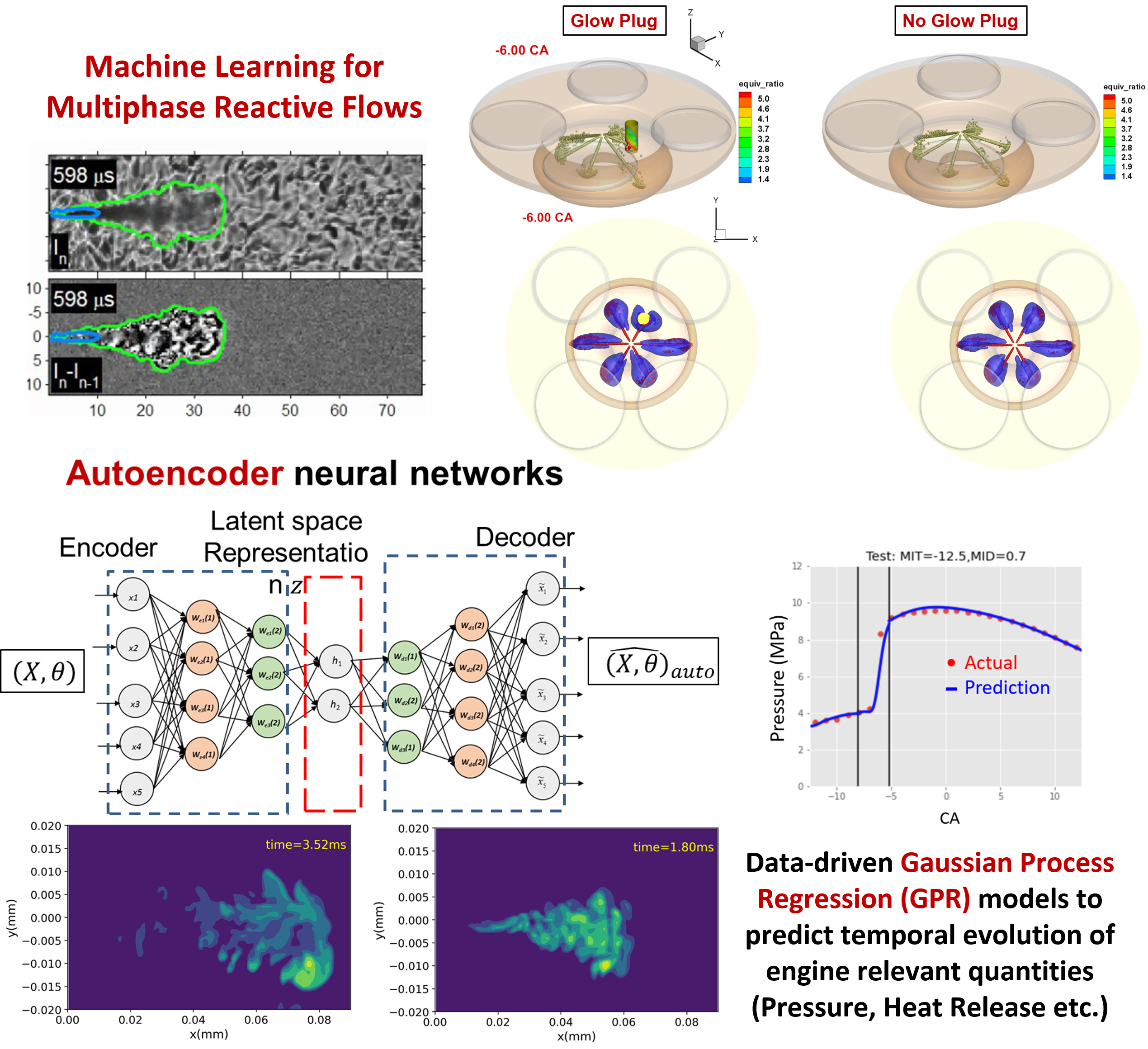Overview of our research
Most of the energy in the world is produced by combustion of fossil and renewable fuels, and this situation will not change in both the short-term and long-term future. To harness combustion energy in an efficient, sustainable, and clean manner, more aggressive optimized designs, active control, and new concept technology are needed. These will not be possible without predictive computational models (computational fluid dynamics, CFD) and fundamental understanding of the associated physical and chemical processes, which are extremely challenging due to the multi-physics and multi-scale nature of turbulent reacting/multiphase flows (combustion, plasmas, particulate & gas-liquid flows, and hypersonics). Based on both science and application, our research can be classified into 5 categories on the cutting-edge topics of turbulent reacting/multiphase flow science and technology:
- High-pressure transcritical/supercritical multiphase flows;
- High-speed reacting flows (both internal & external flows);
- Plasma assisted combustion, fuel reforming, and chemical manufacturing;
- Particles in combustion emission (primarily soot) and nanomaterial synthesis (e.g., TiO2);
- Data-driven surrogate modeling of reactive/multiphase flows for the control and design of propulsion & power systems.
High-Pressure Transcritical/Supercritical Multiphase Flows
Sponsors: Office of Naval Research (ONR) Young Investigator Program (YIP) Award, National Science Foundation (NSF)-CBET
Background and Motivation: Due to the high-pressure environment in advanced propulsion & power systems (e.g., diesel engines, high-power gas turbines, liquid rocket engines, and future rotating detonation engines), the injected liquid propellants are often at thermodynamically transcritical or supercritical states during the spray breakup, evaporation, mixing, and combustion processes. It is well-known that ideal gas law does not hold any more, and real-fluid equation of state (EOS) is required. However, the underlying physics of transcritical or supercritical fluid flows has not been fully understood, especially for multicomponent mixtures.
CFD Modeling: We developed several unique vapor-liquid equilibrium (VLE)-based CFD solvers based on first principles of multiphase thermodynamics (one of the very few such CFD solvers in the US and world) to predict real mixture critical points and capture phase change at high pressures. We then developed an in situ adaptive tabulation (ISAT) method to accelerate the computationally expensive VLE solver by more than one order of magnitude. For the first time in the world, we enabled VLE-based CFD for multiphase systems with more than two components. Starting from the low-pressure volume of fluid (VOF) method, we will develop a VLE-based phase field method to model high-pressure transcritical vapor-liquid phase separation, thickened interfaces and the associated weakened surface tension. To conduct large eddy simulation (LES), we will also develop the associated subgrid-scale (SGS) models for filtered VLE equation, filtered real-fluid EOS, and SGS droplets/bubbles.
High-Speed Turbulent Reacting Flows
Sponsors: Defense Advanced Research Projects Agency (DARPA) Young Faculty Award (YFA) and Director's Fellowship Award, Army Research Office (ARO)
Background and Motivation: In scramjet combustors for hypersonic flights, the residence times are too short for ignition to occur, and the high-speed flows make the flames very difficult to stabilize. Rotating detonation engines (RDEs) is a pressure-gain combustion system to enable higher efficiency for future gas turbines and rocket engines. Comparing to scramjets, many new physics (e.g., deflagration-to-detonation transition, turbulence-detonation interactions) and challenges are introduced by RDEs. Finally, external hypersonic aerothermodynamics introduce significant nonequilibrium and endothermic air reactions to interact with turbulence.
Fast Computing of Chemistry: Accuracy of reactive flow simulation relies on very detailed chemistry (tens to hundreds of species and hundreds to thousands of reactions), whose calculation is the largest computation cost (typically more than 80%) in the simulation of high-speed turbulent combustion systems (e.g., scramjets and RDEs). We developed a series of offline and online methods for chemistry calculation reduction, which provide a significant speed-up (20~50 times). Specifically in the online method, the locally optimized reduced chemistry and its solutions are generated and tabulated on-the-fly, to minimize the computation cost and to avoid repeating calculations at different spatial locations and different time instances.
Another challenge for the simulations of high-speed reacting flows is modeling the compressible turbulence-chemistry interactions (TCI) in nonequilibrium high-speed flows. Enabled by my chemistry calculation reduction tools, I conducted a series of large-scale direct numerical simulation (DNS) of turbulent combustion, and found that the uncertainty of chemistry models can be significantly amplified by turbulence, which raises a higher standard for future measurement and calibration of chemistry models. My group also developed a state-of-the-art fully-compressible reacting flow solver as the platform for high-speed flow simulations. We then implemented a conservative chemical explosive mode analysis (CCEMA) tool and linked it with our unique global reaction pathway analysis (GPA) tool to investigate the compressible TCI. In the next step, we plan to extend CCEMA to a computational singular perturbation (CSP) framework and couple it with Fourier/wavelet transform to create a brand-new description of TCI, which will eventually become a reduced-order model based on first principles for low computational cost.
In external hypersonic aerothermodynamics, the thermodynamic nonequilibrium and endothermic air reactions can significantly affect the sonic boom signatures. Sonic boom is a very important problem for supersonic/hypersonic aerodynamics: (i) sonic boom is one of the primary energy sinks, and hence minimizing sonic boom can reduce energy loss and enhance efficiency; (ii) the strong noise pollution generated by sonic boom will harm the health of humans (e.g., warfighters) and animals; (iii) low-boom design can minimize structural damage of fractal components; (iv) far-field sonic boom signatures contain a lot of information of the supersonic/hypersonic vehicle performance (e.g. lift-to-drag ratio), many of which cannot be detected by traditional approaches such as satellite images. We are conducting CFD simulation to develop a novel line-distributed energy impulse source theory to consider the effects of lift, vehicle shape, (nonequilibrium) thermochemistry, turbulence and (conjugate) heat transfer in the prediction of hypersonic sonic boom. All these effects have never been considered for sonic boom theories before our project.
Plasma Assisted Combustion (PAC), Fuel Reforming, and Chemical Manufacturing
Sponsors: National Science Foundation (NSF)-CBET, Advanced Research Projects Agency–Energy (ARPA-E) REMEDY
Background and Motivation: Non-equilibrium plasma discharge can extend the fuel-lean flammability limit for clean combustion, and significantly shorten ignition delays to serve as a promising igniter for scramjets, because the ignition time must be smaller than the flow resident time during the hypersonic flights. In addition, plasma can convert one fuel to another fuel (i.e., fuel reforming): e.g., methane to liquid fuel for easy storage and transportation, and biomass to ammonia and hydrogen for zero-carbon combustion.
Towards Zero Greenhouse Gas Emissions: We have been investigating plasma assisted ammonia combustion. Ammonia (NH3) is a carbon-free hydrogen-carrier with zero greenhouse gas emission from its combustion. However, ammonia combustion has several key limitations: (i) it is very difficult to ignite ammonia; (ii) ammonia flame is unstable and can be easily blow out; (iii) ammonia combustion generate much more NOx than traditional hydrocarbon combustion. In our study, we found that plasma can mitigate all these three limitations simultaneously and discovered the underlying thermochemical reasons for the first time. In particular, reducing NOx by plasma is counter-intuitive, because plasma actually enhances NOx formation in hydrocarbon combustion. We found that plasma can reform NH3 to N2 and H2 at low temperatures before the ignition, such that there is much less NH3 left for oxidation to NOx after ignition. We will also investigate plasma-assisted in-situ reforming of flare gases to achieve near-zero methane emissions.
CFD Modeling: Due to the multi-scale and multi-physics nature of plasma assisted combustion (PAC) and fuel reforming, state-of-the-art of its detailed modeling is only up to 0D/1D (a series of unique multi-timescale solver developed by us), and its interaction with turbulence has never been investigated numerically. We have been developing a series of reduced-order manifold model based on the information from the detailed 0D/1D solutions to significantly reduce the computational cost of 2D/3D simulations, and developing a presumed sub-filter PDF model to capture the turbulence-plasma interactions in large eddy simulations (LES). This will be a pioneer 2D/3D turbulent PAC solver based on first principles. The first version has been developed in 2021 and successfully applied to plasma assisted ignition in a homogeneous isotropic turbulence. The solver will be used to investigate the plasma-induced stabilization of turbulent auto-ignited jet flames for gas turbines and for flare systems. With this unique capacity, we are also investigating turbulent plasma assisted ultra-fast ignition for scramjets.
Particles in Combustion Emission (primarily soot) and Nanomaterial Synthesis
Sponsor: National Science Foundation (NSF)-CBET
Particle Modeling: The large number of particles involved in combustion engine emission (primarily soot) and advanced manufacturing are infeasible to be individually resolved or tracked in CFD. Instead, the practical way is to model them in a statistical sense: i.e., either capture the number density function (NDF) or statistical moments in the size (e.g., in terms of diameter or volume) and shape (e.g., in terms of surface area) space. In my group, we develop and use several unique methods for such statistical modeling, including (i) the classical hybrid method of moments (HMOM) developed by Prof. Mueller et al.; and (ii) the multi-moment sectional method (MMSM) developed by Prof. Yang et al.
In real applications, turbulence is ubiquitous, and the complicated turbulence-chemistry-particle interactions introduce much higher modeling uncertainty than the statistical particle modeling itself. Prof. Yang et al. developed a conditional particle sub-filter probability density function (PDF) model and a strain-sensitive transport approach (SSTA) to accurately capture such complicated interactions, and reduce the prediction error by more than one order of magnitude.
Particle Chemistry: It is well-known from experiments that high pressure combustion generates much more soot than the atmospheric pressure counterpart. But the underlying physical and chemical reasons are unclear. Based on the simulation results from our aforementioned high-fidelity models, we further developed a unique soot-based global pathway analysis (SGPA) tool, which reveal the detailed reasons for the first time.
Finally, we extended our models to flame synthesis of nanoparticles (e.g., TiO2, SiO2, graphene) with electronics, energy, agricultural and biomedical applications. The resulted high-fidelity predictive tool can significantly shorten the life cycle of reactor development, and enable unprecedented high production rates.
Data-Driven Surrogate Modeling of Reactive/Multiphase Flows for the Control and Design of Propulsion & Power Systems
Sponsor: Army Research Laboratory (ARL)
Background and Motivation: The high computational cost of CFD is not practical for the control and design in propulsion & power industry, in which hundreds or thousands of cases are needed for parametric studies to optimize the design or to actively control the system operation. In particular, active control requires a decision within a millisecond, which is impossible for CFD.
Surrogate Modeling: We are developing CFD-based data-driven surrogate models to enable super-fast emulation of reactive flows for the active control of unmanned aerial vehicle (UAV) engines. Both statistical models (e.g., Kriging) and neural networks (NNs) are used in the development.





